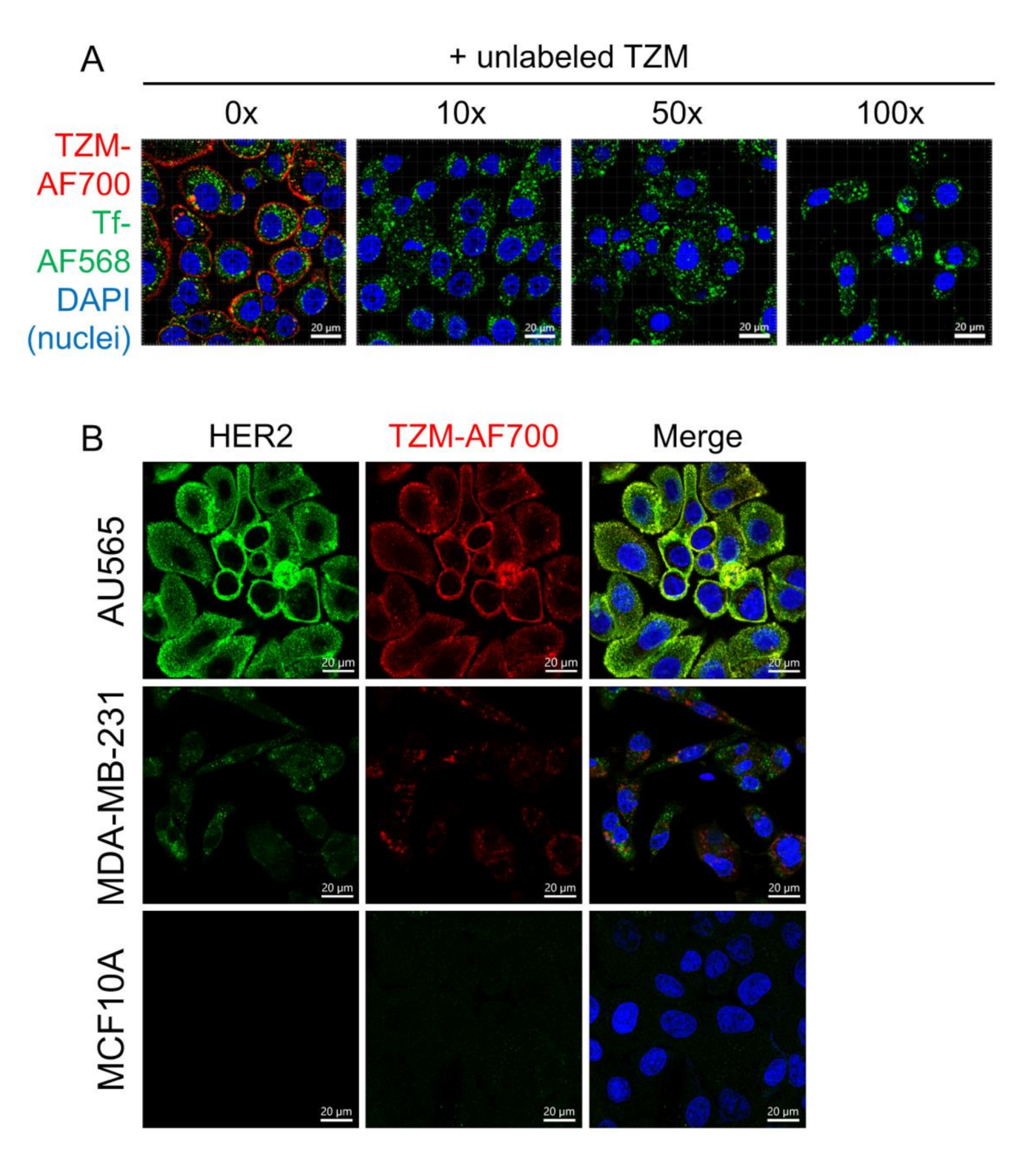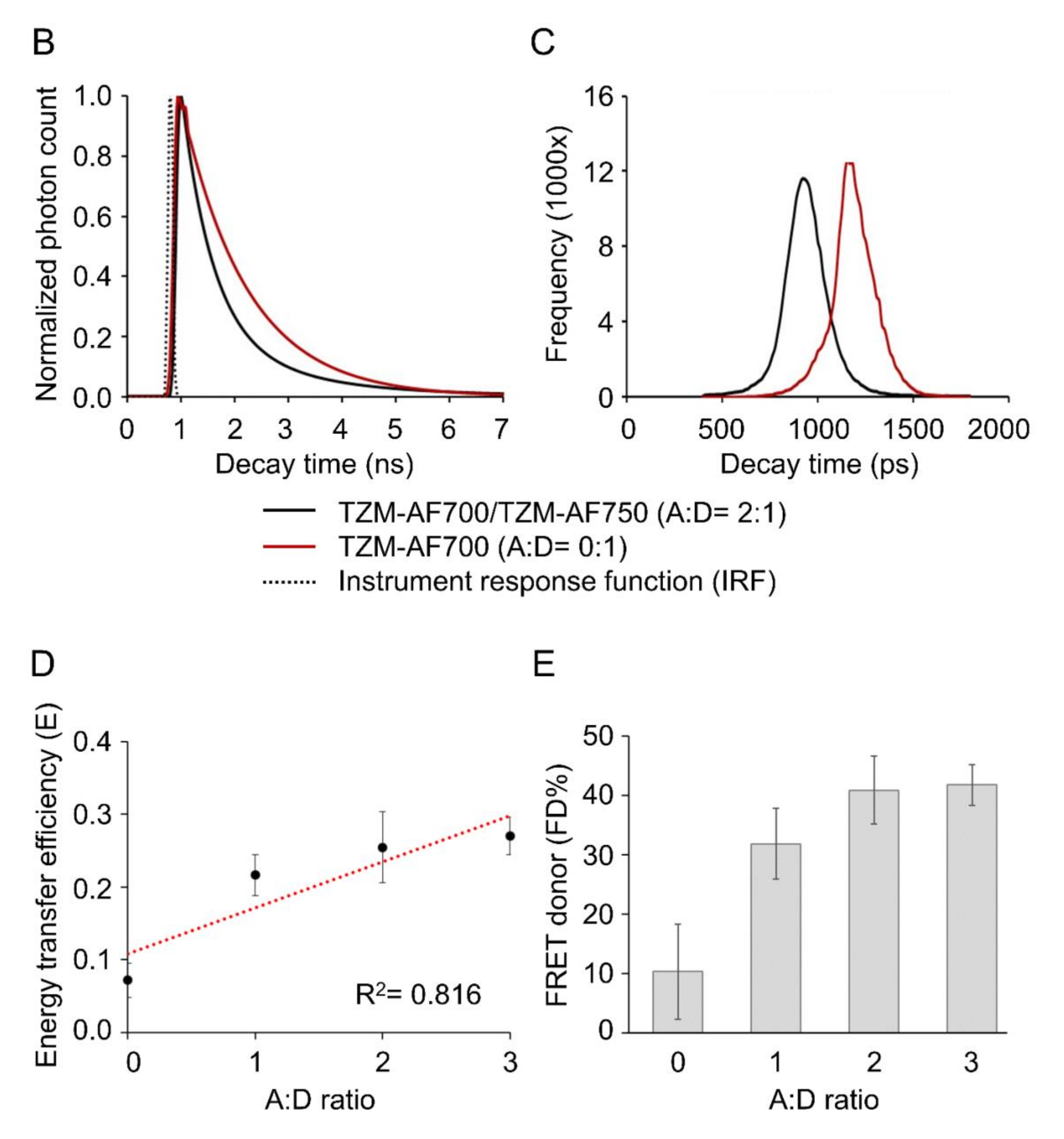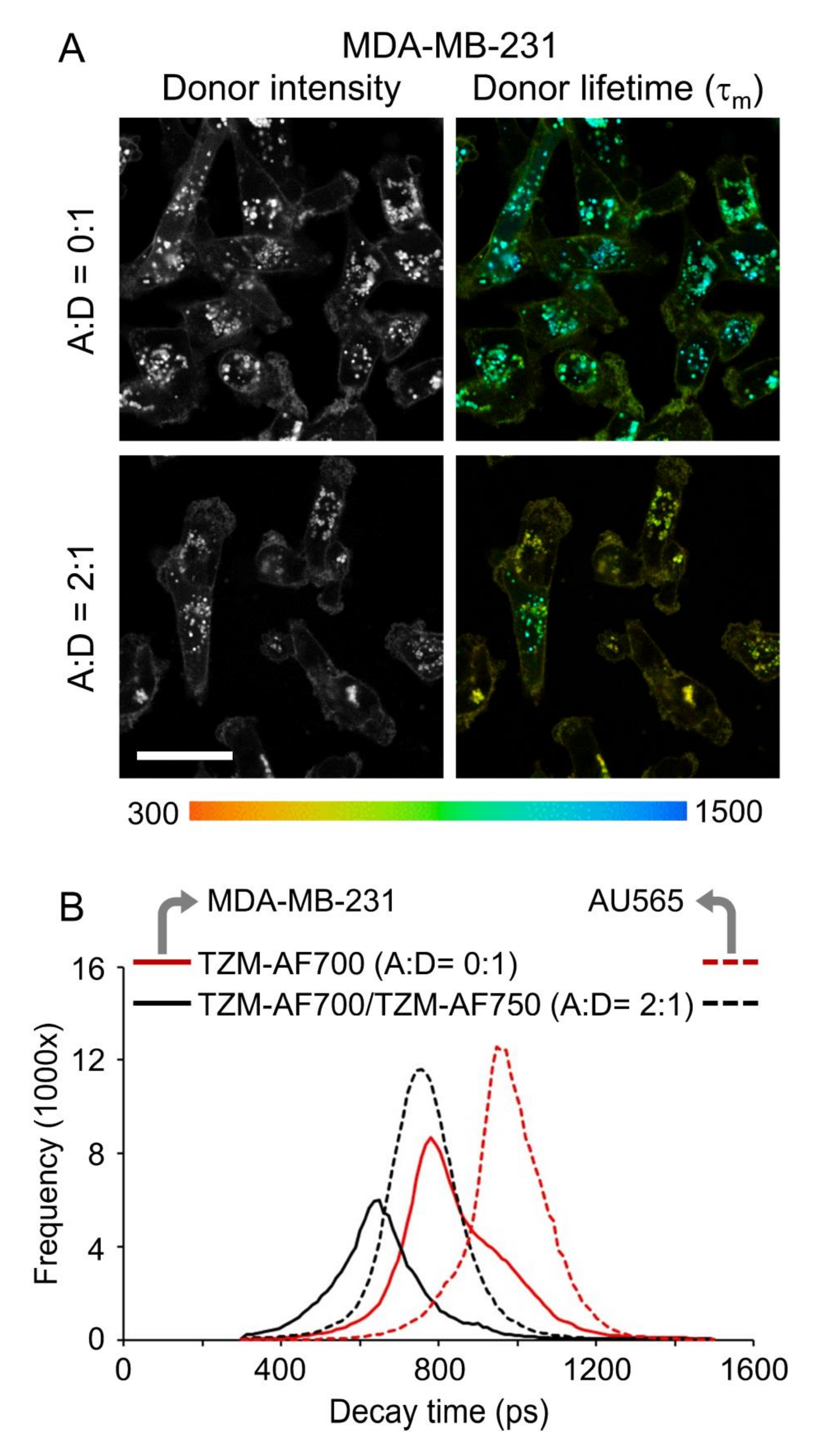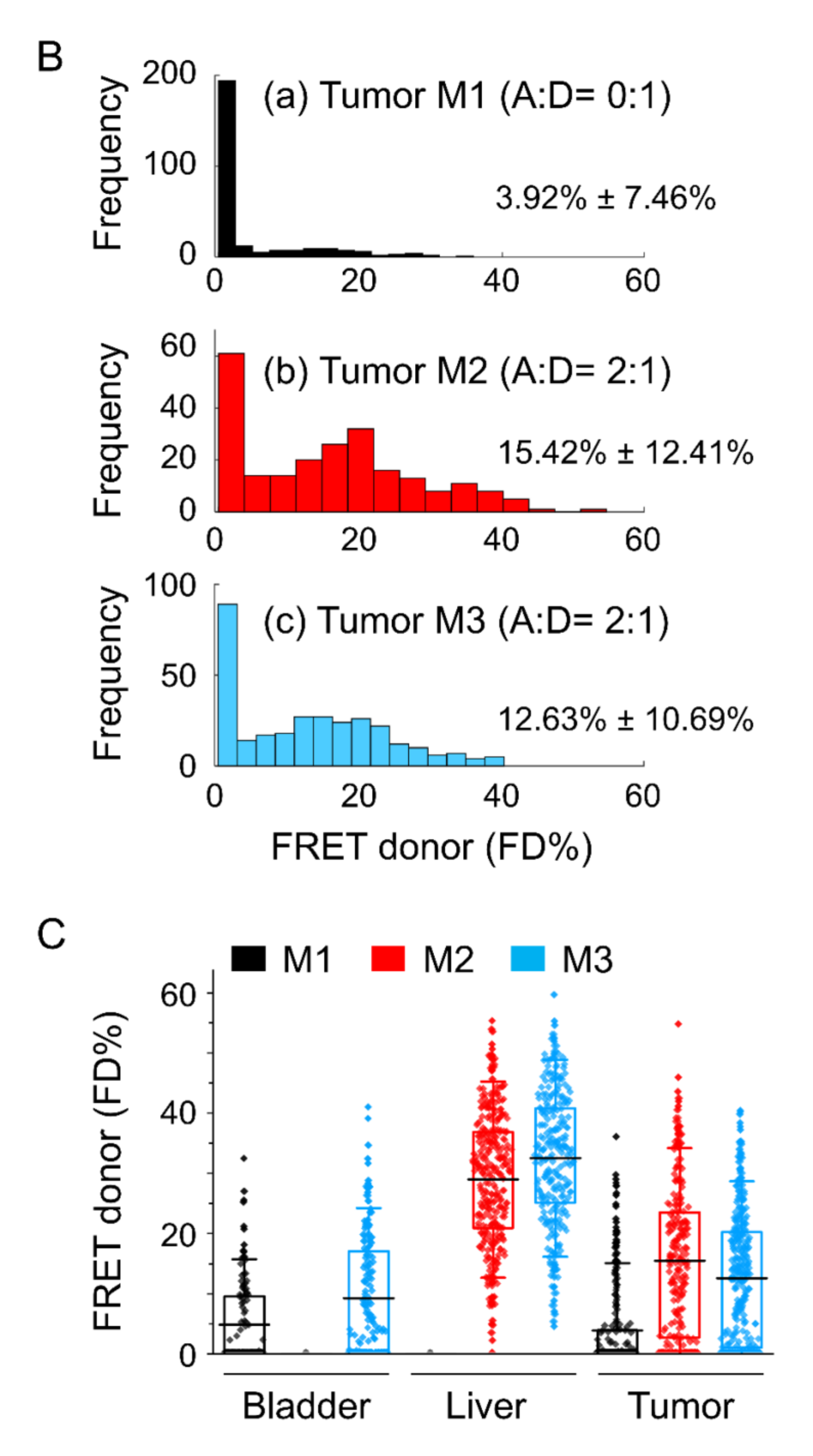Quantification of Trastuzumab–HER2 Engagement In Vitro and In Vivo
Abstract
1. Introduction
2. Results
2.1. TZM–AF700 Binding and Trafficking in AU565 Breast Cancer Cells
2.2. Quantification of TZM–HER2 Engagement in Cell-Based Assays
2.3. Quantification of TZM–HER2 Engagement in AU565 Breast Cancer Xenografts
2.4. Histological Evaluation of AU565 Breast Cancer Xenografts
3. Discussion
4. Materials and Methods
4.1. Cell Culture
4.2. TZM Labeling
4.3. Uptake and Immunofluorescence Assays Using Confocal Microscopy
4.4. NIR FLIM-FRET Microscopy
4.5. Animal Experiments
4.6. Wide-Field Macroscopic Fluorescence Lifetime Imaging Platform
4.7. Bi-Exponential Fitting to Extract FRET Donor Fraction
4.8. Immunohistochemistrycoherent,Inc
4.9. Statistical Analysis
Supplementary Materials
Author Contributions
Funding
Acknowledgments
Conflicts of Interest
References
- Yan, M.; Schwaederle, M.; Arguello, D.; Millis, S.Z.; Gatalica, Z.; Kurzrock, R. HER2 expression status in diverse cancers: Review of results from 37,992 patients. Cancer Metastasis Rev. 2015, 34, 157–164. [Google Scholar] [CrossRef]
- Swain, S.M.; Baselga, J.; Kim, S.B.; Ro, J.; Semiglazov, V.; Campone, M.; Ciruelos, E.; Ferrero, J.M.; Schneeweiss, A.; Heeson, S.; et al. Pertuzumab, trastuzumab, and docetaxel in HER2-positive metastatic breast cancer. N. Engl. J. Med. 2014, 372, 724–734. [Google Scholar] [CrossRef]
- Boku, N. HER2-positive gastric cancer. Gastric Cancer 2014, 17, 1–12. [Google Scholar] [CrossRef] [PubMed]
- Kümler, I.; Tuxen, M.K.; Nielsen, D.L. A systematic review of dual targeting in HER2-positive breast cancer. Cancer Treat. Rev. 2014, 40, 259–270. [Google Scholar] [CrossRef] [PubMed]
- Vu, T.; Claret, F.X. Trastuzumab: Updated mechanisms of action and resistance in breast cancer. Front. Oncol. 2012, 2, 62. [Google Scholar] [CrossRef] [PubMed]
- Valabrega, G.; Montemurro, F.; Aglietta, M. Trastuzumab: Mechanism of action, resistance and future perspectives in HER2-overexpressing breast cancer. Ann. Oncol. 2007, 18, 977–984. [Google Scholar] [CrossRef] [PubMed]
- Gu, G.; Dustin, D.; Fuqua, S.A. Targeted therapy for breast cancer and molecular mechanisms of resistance to treatment. Curr. Opin. Pharmacol. 2016, 31, 97–103. [Google Scholar] [CrossRef] [PubMed]
- Stefaniak, J.; Huber, K.V.M. Importance of Quantifying Drug-Target Engagement in Cells. ACS Med. Chem. Lett. 2020, 11, 403–406. [Google Scholar] [CrossRef]
- Heskamp, S.; Van Laarhoven, H.W.; Van Der Graaf, W.T.; Oyen, W.J.; Boerman, O.C. Radionuclide imaging of drug delivery for patient selection in targeted therapy. Expert Opin. Drug Deliv. 2014, 11, 175–185. [Google Scholar] [CrossRef]
- Massicano, A.V.F.; Marquez-Nostra, B.V.; Lapi, S.E. Targeting HER2 in Nuclear Medicine for Imaging and Therapy. Mol. Imaging 2018, 17, 1–11. [Google Scholar] [CrossRef]
- Pereira, P.M.R.; Abma, L.; Henry, K.E.; Lewis, J.S. Imaging of human epidermal growth factor receptors for patient selection and response monitoring–From PET imaging and beyond. Cancer Lett. 2018, 419, 139–151. [Google Scholar] [CrossRef] [PubMed]
- Licha, K.; Olbrich, C. Optical imaging in drug discovery and diagnostic applications. Adv. Drug Deliv. Rev. 2005, 57, 1087–1108. [Google Scholar] [CrossRef] [PubMed]
- Rajoria, R.; Zhao, L.; Intes, X.; Barroso, M. FLIM-FRET for Cancer Applications. Curr. Mol. Imaging 2014, 3, 144–161. [Google Scholar] [CrossRef] [PubMed][Green Version]
- Berezin, M.M.Y.; Achilefu, S. Fluorescence Lifetime Measurements and Biological Imaging. Chem. Rev. 2011, 110, 2641–2684. [Google Scholar] [CrossRef]
- Rudkouskaya, A.; Faulkner, D.E.; Sinsuebphon, N.; Intes, X.; Barroso, M. Macroscopic Fluorescence Lifetime-Based Förster Resonance Energy Transfer Imaging for Quantitative Ligand–Receptor Binding. In Biomaterials for Cancer Therapeutics: Evolution and Innovation; Park, K., Ed.; Woodhead, Woodhead Publishing Series in Biomaterials: Cambridge, UK, 2020; pp. 331–363. ISBN 9780081029831. [Google Scholar]
- Wallrabe, H.; Bonamy, G.; Periasamy, A.; Barroso, M. Receptor complexes cotransported via polarized endocytic pathways form clusters with distinct organizations. Mol. Biol. Cell 2007, 18, 2226–2243. [Google Scholar] [CrossRef][Green Version]
- Talati, R.; Vanderpoel, A.; Eladdadi, A.; Anderson, K.; Abe, K.; Barroso, M. Automated selection of regions of interest for intensity-based FRET analysis of transferrin endocytic trafficking in normal vs. cancer cells. Methods 2014, 66, 139–152. [Google Scholar] [CrossRef][Green Version]
- Rudkouskaya, A.; Sinsuebphon, N.; Ward, J.; Tubbesing, K.; Intes, X.; Barroso, M. Quantitative Imaging of Receptor-Ligand Engagement in Intact Live Animals. J. Control. Release 2018, 286, 451–459. [Google Scholar] [CrossRef]
- Abe, K.; Zhao, L.; Periasamy, A.; Intes, X.; Barroso, M. Non-invasive In Vivo imaging of near infrared-labeled transferrin in breast cancer cells and tumors using fluorescence lifetime FRET. PLoS ONE 2013, 8, e80269. [Google Scholar] [CrossRef]
- Matthews, P.M.; Rabiner, E.A.; Passchier, J.; Gunn, R.N. Positron emission tomography molecular imaging for drug development. Br. J. Clin. Pharmacol. 2012, 73, 175–186. [Google Scholar] [CrossRef]
- Sinsuebphon, N.; Rudkouskaya, A.; Barroso, M.; Intes, X. Comparison of illumination geometry for lifetime-based measurements in whole-body preclinical imaging. J. Biophotonics 2018, 11, e201800037. [Google Scholar] [CrossRef]
- Smith, J.T.; Yao, R.; Sinsuebphon, N.; Rudkouskaya, A.; Mazurkiewicz, J.; Barroso, M.; Yan, P.; Intes, X. Fast fit-free analysis of fluorescence lifetime imaging via deep learning. Proc. Natl. Acad. Sci. USA 2019, 116, 24019–24030. [Google Scholar] [CrossRef] [PubMed]
- Smith, J.; Ochoa, M.; Intes, X. UNMIX-ME: Spectral and lifetime fluorescence unmixing via deep learning. Biomed. Opt. Express 2020, 11, 3857–3874. [Google Scholar] [CrossRef] [PubMed]
- Rudkouskaya, A.; Sinsuebphon, N.; Ochoa, M.; Chen, S.-J.; Mazurkiewicz, J.E.; Intes, X.; Barroso, M. Multiplexed Non-Invasive Tumor Imaging of Glucose Metabolism and Receptor-Ligand Engagement using Dark Quencher FRET Acceptor. Theranostics 2020, 10, 10309–10325. [Google Scholar] [CrossRef] [PubMed]
- Maxfield, F.R.; McGraw, T.E. Endocytic recycling. Nat. Rev. Mol. Cell Biol. 2004, 5, 121–132. [Google Scholar] [CrossRef] [PubMed]
- Tubbesing, K.; Ward, J.; Abini-Agbomson, R.; Malhotra, A.; Rudkouskaya, A.; Warren, J.; Lamar, J.; Martino, N.; Adam, A.P.; Barroso, M. Complex Rab4-Mediated Regulation of Endosomal Size and EGFR Activation. Mol. Cancer Res. 2020, 18, 757–773. [Google Scholar] [CrossRef]
- Mayle, K.M.; Le, A.M.; Kamei, D.T. The intracellular trafficking pathway of transferrin. Biochim. Biophys. Acta Gen. Subj. 2012, 1820, 264–281. [Google Scholar] [CrossRef]
- Luck, A.N.; Mason, A.B. Transferrin-Mediated Cellular Iron Delivery. Curr. Top. Membr. 2012, 69, 3–35. [Google Scholar] [CrossRef]
- Ram, S.; Kim, D.; Ober, R.J.; Ward, E.S. The level of HER2 expression is a predictor of antibody-HER2 trafficking behavior in cancer cells. MAbs 2014, 6, 1211–1219. [Google Scholar] [CrossRef]
- Pietilä, M.; Sahgal, P.; Peuhu, E.; Jäntti, N.Z.; Paatero, I.; Närvä, E.; Al-Akhrass, H.; Lilja, J.; Georgiadou, M.; Andersen, O.M.; et al. SORLA regulates endosomal trafficking and oncogenic fitness of HER2. Nat. Commun. 2019, 10, 2340. [Google Scholar] [CrossRef]
- Rudkouskaya, A.; Smith, J.T.; Ochoa, M.; Intes, X.; Barroso, M. Quantification of anti-HER2 drug internalization in human breast cancer cells and tumor xenografts using fluorescence lifetime FRET imaging. Proc. SPIE 2020, 11219, 112190C. [Google Scholar] [CrossRef]
- Oh, D.Y.; Bang, Y.J. HER2-targeted therapies—A role beyond breast cancer. Nat. Rev. Clin. Oncol. 2020, 17, 33–48. [Google Scholar] [CrossRef] [PubMed]
- Pereira, P.M.R.; Mandleywala, K.; Ragupathi, A.; Carter, L.M.; Goos, J.A.C.M.; Janjigian, Y.Y.; Lewis, J.S. Temporal modulation of HER2 membrane availability increases pertuzumab uptake and pretargeted molecular imaging of gastric tumors. J. Nucl. Med. 2019, 60, 1569–1578. [Google Scholar] [CrossRef] [PubMed]
- Pereira, P.M.R.; Janjigian, Y.Y.; Durack, J.C.; Carter, L.M.; Ragupathi, A.; Pourat, J.; Edwards, K.J.; Lewis, J.S.; Sharma, S.K. Caveolin-1 mediates cellular distribution of HER2 and affects trastuzumab binding and therapeutic efficacy. Nat. Commun. 2018, 9, 5137. [Google Scholar] [CrossRef] [PubMed]
- Park, K. Quantitative non-invasive imaging of target engagement in small animals. J. Control. Release 2018, 286, 485. [Google Scholar] [CrossRef]
- Chen, S.J.; Sinsuebphon, N.; Rudkouskaya, A.; Barroso, M.; Intes, X.; Michalet, X. In Vitro and In Vivo phasor analysis of stoichiometry and pharmacokinetics using short-lifetime near-infrared dyes and time-gated imaging. J. Biophoton. 2018, 12, e201800185. [Google Scholar] [CrossRef]
- Kaufmann, R.; Müller, P.; Hildenbrand, G.; Hausmann, M.; Cremer, C. Analysis of Her2/neu membrane protein clusters in different types of breast cancer cells using localization microscopy. J. Microsc. 2011, 242, 46–54. [Google Scholar] [CrossRef]
- Chung, I.; Reichelt, M.; Shao, L.; Akita, R.W.; Koeppen, H.; Rangell, L.; Schaefer, G.; Mellman, I.; Sliwkowski, M.X. High cell-surface density of HER2 deforms cell membranes. Nat. Commun. 2016, 7, 12742. [Google Scholar] [CrossRef]
- Tobin, S.J.; Wakefield, D.L.; Jones, V.; Liu, X.; Schmolze, D.; Jovanović-Talisman, T. Single molecule localization microscopy coupled with touch preparation for the quantification of trastuzumab-bound HER2. Sci. Rep. 2018, 8, 1–13. [Google Scholar] [CrossRef]
- Ardeshirpour, Y.; Sackett, D.L.; Knutson, J.R.; Gandjbakhche, A.H. Using In Vivo fluorescence lifetime imaging to detect HER2-positive tumors. EJNMMI Res. 2018, 8, 1–6. [Google Scholar] [CrossRef]
- Riccio, G.; Esposito, G.; Leoncini, E.; Contu, R.; Condorelli, G.; Chiariello, M.; Laccetti, P.; Hrelia, S.; D’Alessio, G.; De Lorenzo, C. Cardiotoxic effects, or lack thereof, of anti-ErbB2 immunoagents. FASEB J. 2009, 23, 3171–3178. [Google Scholar] [CrossRef]
- Yan, H.; Endo, Y.; Shen, Y.; Rotstein, D.; Dokmanovic, M.; Mohan, N.; Mukhopadhyay, P.; Gao, B.; Pacher, P.; Wu, W.J. Ado-trastuzumab emtansine targets hepatocytes via human epidermal growth factor receptor 2 to induce hepatotoxicity. Mol. Cancer Ther. 2016, 15, 480–490. [Google Scholar] [CrossRef] [PubMed]
- McLarty, K.; Cornelissen, B.; Cai, Z.; Scollard, D.A.; Costantini, D.L.; Done, S.J.; Reilly, R.M. Micro-SPECT/CT with 111In-DTPA-pertuzumab sensitively detects trastuzumab-mediated HER2 downregulation and tumor response in athymic mice bearing MDA-MB-361 human breast cancer xenografts. J. Nucl. Med. 2009, 50, 1340–1348. [Google Scholar] [CrossRef] [PubMed]
- Chan, C.; Scollard, D.A.; McLarty, K.; Smith, S.; Reilly, R.M. A comparison of 111 In- or 64Cu-DOTA-trastuzumab Fab fragments for imaging subcutaneous HER2- positive tumor xenografts in athymic mice using microSPECT/CT or microPET/CT. EJNMMI Res. 2011, 1, 1–11. [Google Scholar] [CrossRef] [PubMed]
- Heston, W.E. Biology of the laboratory mouse. J. Hered. 1967, 58, 16. [Google Scholar] [CrossRef]
- Venugopal, V.; Chen, J.; Intes, X. Development of an optical imaging platform for functional imaging of small animals using wide- field excitation. Biomed. Opt. Express 2010, 1, 143–156. [Google Scholar] [CrossRef]
- Zhao, L.; Abe, K.; Rajoria, S.; Pian, Q.; Barroso, M.; Intes, X. Spatial light modulator based active wide-field illumination for ex vivo and in vivo quantitative NIR FRET imaging. Biomed. Opt. Express 2014, 5, 944. [Google Scholar] [CrossRef] [PubMed]









Sample Availability: Samples of the compounds are available from the authors. |
Publisher’s Note: MDPI stays neutral with regard to jurisdictional claims in published maps and institutional affiliations. |
© 2020 by the authors. Licensee MDPI, Basel, Switzerland. This article is an open access article distributed under the terms and conditions of the Creative Commons Attribution (CC BY) license (http://creativecommons.org/licenses/by/4.0/).
Share and Cite
Rudkouskaya, A.; Smith, J.T.; Intes, X.; Barroso, M. Quantification of Trastuzumab–HER2 Engagement In Vitro and In Vivo. Molecules 2020, 25, 5976. https://doi.org/10.3390/molecules25245976
Rudkouskaya A, Smith JT, Intes X, Barroso M. Quantification of Trastuzumab–HER2 Engagement In Vitro and In Vivo. Molecules. 2020; 25(24):5976. https://doi.org/10.3390/molecules25245976
Chicago/Turabian StyleRudkouskaya, Alena, Jason T. Smith, Xavier Intes, and Margarida Barroso. 2020. "Quantification of Trastuzumab–HER2 Engagement In Vitro and In Vivo" Molecules 25, no. 24: 5976. https://doi.org/10.3390/molecules25245976
APA StyleRudkouskaya, A., Smith, J. T., Intes, X., & Barroso, M. (2020). Quantification of Trastuzumab–HER2 Engagement In Vitro and In Vivo. Molecules, 25(24), 5976. https://doi.org/10.3390/molecules25245976





